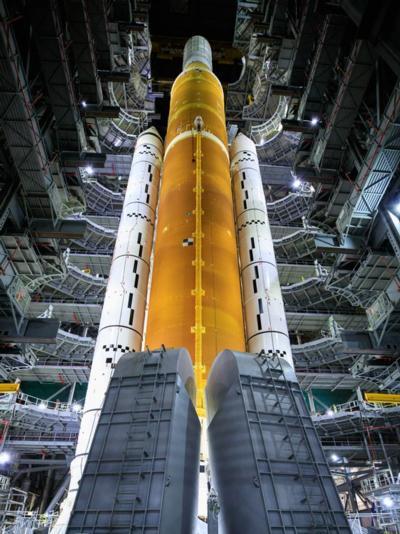Sun, Dec 05, 2021
Solid Rocket Launch Systems To Be Used in Artemis and Beyond
NASA has awarded the Booster Production and Operations Contract to Northrop Grumman for the agency's upcoming Space Launch System rockets. The launch system will be the primary system for use in the first 3 Artemis missions, with likely inclusion for the 4th.

The contract comes in at a value of $3.19 billion, finalizing a contract awarded in 2020 that authorized Grumman to build the labor-intensive, expensive twin boosters for the next 6 SLS flights. The contract stands through 2031 and includes all the necessary flight materials and support equipment, as well as operations for the SLS. Artemis missions IV-VIII will see benefits of the design, development, testing, and evaluation of the boosters, with Artemis IX seeing bolstered specifications under the Booster Obsolescence and Life Extension (BOLE) program. The twin solid rocket boosters will account for more than three quarters of the thrust for each SLS launch, mounted on the sides of the core stage. Their design builds on the older space shuttle rocket systems, with an additional segment vital to lifting the increased payload. The BOLE design process is expected to update the current system's steel casing with a stronger, lighter composite case, upgraded structures, electronic thrust vectoring,
and improved propellant materials.
The deal is a superb win for Grumman, snapping up what is essentially the spinal column of NASA's future deep space exploration. Without the SLS rocket and Orion spacecraft, NASA would lack critical mission capabilities to land the first woman and person of color on the surface of the moon. Eventually, those missions are hoped to give way to a long-term lunar presence that serves as a stepping stone on the way to Mars.
“Our boosters are ready to launch the first flight of the Space Launch System on the Artemis I mission, and we are making great progress producing boosters for the Artemis II, III, and IV missions,” said Bruce Tiller, NASA's SLS booster manager. “Upgrading the booster’s performance ensures we can improve SLS’s ability to send astronauts and cargo to the Moon as well as making our processes more efficient.”
More News
Its Offerings Are Lighter, Cleaner, and Now Pushing Past 1,000nm on SAF Jet Fuel DeltaHawk’s diesel-powered aircraft lineup has seen incredible upgrades over the last few yea>[...]
The Airplane Experienced A Total Loss Of Engine Power On December 3, 2025, about 1600 central standard time, a Mooney Aircraft Corp. M20K, N57229, was substantially damaged when it>[...]
Make Sure You NEVER Miss A New Story From Aero-News Network Do you ever feel like you never see posts from a certain person or page on Facebook or Instagram? Here’s how you c>[...]
Aero Linx: European Society of Aerospace Medicine (ESAM) As a pan-European, independent forum, it works to promote the safety and health of all persons involved in aviation and spa>[...]
“We are excited to see Wisk achieve this milestone, and I’m so proud of the team that made it possible. The team at Wisk has built advanced technologies across flight c>[...]
 Aero-TV: DeltaHawks Diesel Power Steps Into the Spotlight
Aero-TV: DeltaHawks Diesel Power Steps Into the Spotlight NTSB Prelim: Mooney Aircraft Corp. M20K
NTSB Prelim: Mooney Aircraft Corp. M20K ANN FAQ: Turn On Post Notifications
ANN FAQ: Turn On Post Notifications ANN's Daily Aero-Linx (12.20.25)
ANN's Daily Aero-Linx (12.20.25) Aero-News: Quote of the Day (12.20.25)
Aero-News: Quote of the Day (12.20.25)



